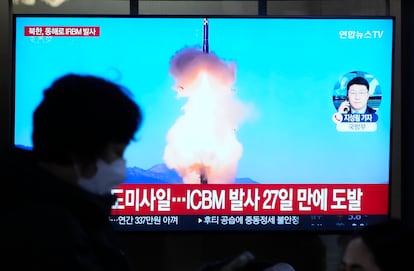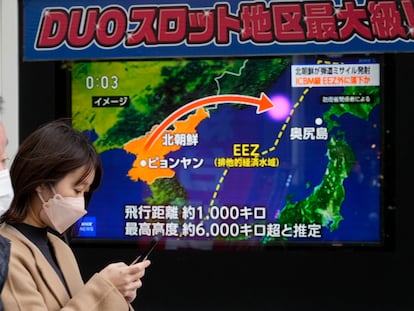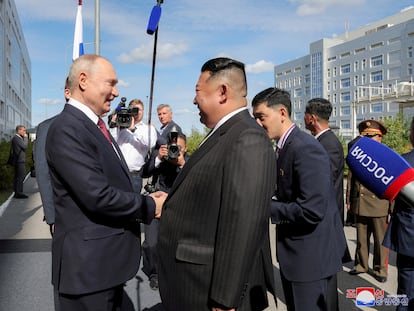North Korea launches suspected intermediate-range ballistic missile that can reach distant US bases
Experts say North Korea could ramp up its provocative missile tests as a way to influence the results of South Korea’s parliamentary elections in April and the U.S. presidential election in November

North Korea fired a suspected intermediate-range ballistic missile into the sea on Sunday, South Korea’s military said, two months after the North claimed to have tested engines for a new harder-to-detect missile capable of striking distant U.S. targets in the region.
The launch was the North’s first this year. Experts say North Korea could ramp up its provocative missile tests as a way to influence the results of South Korea’s parliamentary elections in April and the U.S. presidential election in November.
South Korea’s Joint Chiefs of Staff said in a statement that it detected the launch of a ballistic missile of an intermediate-range class from the North’s capital region on Sunday afternoon. It said the missile flew about 1,000 kilometers (620 miles) before landing in the waters between the Korean Peninsula and Japan.
The Joint Chiefs of Staff called the launch a provocation that poses a serious threat to peace on the Korean Peninsula. It said South Korea’s military will maintain its readiness to overwhelmingly respond to any provocations by North Korea.
The South Korean assessment suggests North Korea could have launched a new intermediate-range ballistic missile, whose solid-fuel engine it said it had tested in mid-November.
The missile is mainly designed to hit U.S. military bases in the U.S. Pacific territory of Guam, which is about 3,400 kilometers (2,110 miles) from Pyongyang, the North’s capital. With a range adjustment, the missile can also be used to attack closer targets — the U.S. military installations in Japan’s Okinawa island, according to Chang Young-keun, a missile expert at the Korea Research Institute for National Strategy in Seoul.
Built-in solid propellants make missile launches harder to detect than liquid-fueled missiles, which must be fueled before launch and cannot last long. North Korea has a growing arsenal of solid-fuel short-range missiles targeting South Korea, but its existing Hwasong-12 intermediate-range missile is powered by liquid-fuel engines.
Japan’s Defense Ministry said its analysis showed the missile traveled at least 500 kilometers (300 miles) at the maximum altitude of 50 kilometers (30 miles), data that suggest North Korea may have fired a short-range and not an intermediate-range missile.
Japan and South Korea said they closely exchanged information about the launch with the United States, but they didn’t immediately explain the discrepancy in data.
The last time North Korea performed a missile launch that was publicly announced was Dec. 18, when it test-fired its Hwasong-18 solid-fueled intercontinental ballistic missile, the North’s most advanced weapon. The Hwasong-18 is the country’s only known solid-fuel ICBM and it’s designed to strike the mainland U.S.
On Jan. 5, North Korea fired a barrage of artillery shells near the disputed western sea boundary with South Korea, prompting South Korea to conduct similar firing exercises in the same area. South Korea accused North Korea of continuing similar artillery barrage in the area for the next two days. The site is where the navies of the two Koreas have fought three bloody sea battles since 1999, and attacks blamed on North Korea killed 50 South Koreans in 2010.
In recent days, North Korea has also been escalating its warlike, inflammatory rhetoric against its foes ahead of an election year in South Korea and the U.S. Leader Kim Jong Un, during visits last week to munitions factories, called South Korea “our principal enemy” and threatened to annihilate it if provoked.
Experts say Kim likely wants to see South Korean liberals win the election and pursue rapprochement with North Korea, and for former U.S. President Donald Trump to be elected again. They say Kim may believe he could win U.S. concessions like sanctions relief if Trump returns to the White House.
Negotiations over North Korea’s advancing nuclear arsenal have been dormant since the Kim-Trump diplomacy broke down in 2019. Kim has since focused on enlarging his nuclear and missile arsenals in what foreign analysts is an effort to boost his leverage. In recent months, North Korea has also been expanding its military and other cooperation with Russia.
The U.S. government said it has evidence that missiles provided by North Korea to Russia had been used in the war in Ukraine. In a joint statement last week, the U.S., South Korea and their partners said the missile transfer supports Russia’s war of aggression and provides North Korea with valuable technical and military insights.
North Korea and Russia announced Sunday that North Korean Foreign Minister Choe Son Hui will visit Russia from Monday to Wednesday at the invitation of her Russian counterpart Sergey Lavrov.
“Pyongyang’s show of force should be of concern beyond Seoul, as its military cooperation with Moscow adds to the violence in Ukraine, and because it may be more willing to challenge the U.S. and its allies while global attention is fixed on the Middle East,” said Leif-Eric Easley, a professor at Ewha University in Seoul.
Sign up for our weekly newsletter to get more English-language news coverage from EL PAÍS USA Edition
Tu suscripción se está usando en otro dispositivo
¿Quieres añadir otro usuario a tu suscripción?
Si continúas leyendo en este dispositivo, no se podrá leer en el otro.
FlechaTu suscripción se está usando en otro dispositivo y solo puedes acceder a EL PAÍS desde un dispositivo a la vez.
Si quieres compartir tu cuenta, cambia tu suscripción a la modalidad Premium, así podrás añadir otro usuario. Cada uno accederá con su propia cuenta de email, lo que os permitirá personalizar vuestra experiencia en EL PAÍS.
¿Tienes una suscripción de empresa? Accede aquí para contratar más cuentas.
En el caso de no saber quién está usando tu cuenta, te recomendamos cambiar tu contraseña aquí.
Si decides continuar compartiendo tu cuenta, este mensaje se mostrará en tu dispositivo y en el de la otra persona que está usando tu cuenta de forma indefinida, afectando a tu experiencia de lectura. Puedes consultar aquí los términos y condiciones de la suscripción digital.
More information
Archived In
Últimas noticias
Raúl Rocha, from jet-setting with Miss Universe to arms trafficking and fuel theft
80,000 barrels of Mexican oil sent to Cuba: Havana drawn into the US–Mexico clash
Human rights activists, opposition members, and a minor: Maduro’s other political prisoners
Israel sparks a civil war within the MAGA movement
Most viewed
- Reinhard Genzel, Nobel laureate in physics: ‘One-minute videos will never give you the truth’
- Pablo Escobar’s hippos: A serious environmental problem, 40 years on
- Charles Dubouloz, mountaineering star, retires at 36 with a farewell tour inspired by Walter Bonatti
- Why we lost the habit of sleeping in two segments and how that changed our sense of time
- The fall of a prolific science journal exposes the billion-dollar profits of scientific publishing










































